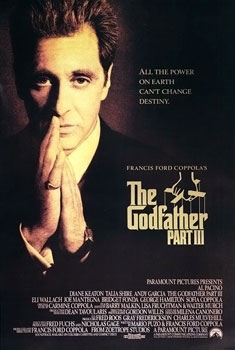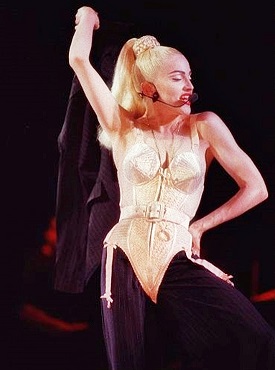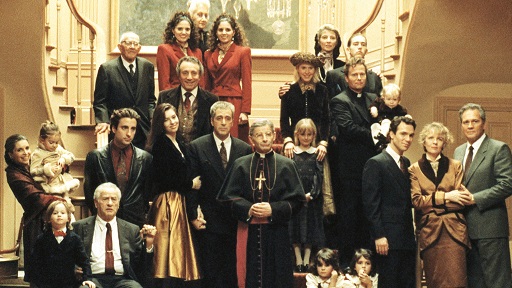If only Tom Hagen had returned….
Recently, when asked about The Godfather Part III‘s somewhat lackluster reputation, director Francis Ford Coppola said that the biggest mistake that Paramount made was refusing to meet Robert Duvall’s salary demands. While Duvall wasn’t demanding to be paid as much as Al Pacino, he still felt that their salaries should be “comparable.” Paramount, who had already gone through a lot of protracted negotiations to get Coppola, Pacino, and Diane Keaton to agree to do the film, disagreed. Originally, Coppola had planned for Duvall’s Tom Hagen to be a major part of Godfather Part III. When Duvall refused to return, the film had to be reimagined.
Coppola’s right. There’s a lot that I do like about The Godfather Part III but it’s undoubtedly a flawed film. (It’s a good gangster film but it never feels like a worthy follow-up to the films that came before it.) And one of the major problems with the film is that Al Pacino’s Michael Corleone doesn’t have anyone with whom he can really confide. Kay (Diane Keaton) holds him at arm’s length for most of the film. Connie (Talia Shire) is too busy scheming and plotting on her own. The rest of the family — Mary (Sofia Coppola), Vincent (Andy Garcia), and Anthony (Franc D’Ambrosio) — are too young to truly understand the sins of the past. If Tom Hagen had been in the film, Michael would have had someone to whom he could relate. He would have had an equal. Hagen’s absence is felt far more than Paramount expected it would be. They should have paid Duvall his five million.
(For his part, Duvall has defended his salary demands by saying that the only reason anyone was making Godfather Part III was for the money so why shouldn’t he get paid? And again, Duvall has a point….)
Of course, for a long time, it seemed like The Godfather Part III would never be made. After The Godfather Part II swept the 1974 Academy Awards and proved wrong everyone who felt that it would fail, Paramount wanted a sequel. The only problem was that Coppola and Pacino both said they wouldn’t return. And, after Coppola disappeared into the jungle for several years and reportedly went mad directing Apocalypse Now, Paramount wasn’t quite sure that they wanted him to return either.
As unthinkable as it may seem now, it was originally quite probable that The Godfather Part III would have featured neither Pacino nor Coppola. Between 1975 and 1988, several different scripts and treatments were written for a possible Part III. Many of them opened with Michael either dying or already dead and his son, Anthony, taking over the family business. Several of the scripts imagined Sonny’s son, Santino, waging war against Anthony and Tom Hagen (yep, Tom again) being forced to take a side. In the 70s, many of the scripts featured the Mafia working with the CIA to take out Castro and there were more than few that suggested the Corleones were responsible for the Kennedy assassinations. As the 70s gave way to the 80s, the scripts started to deal with the Corleones getting involved in the drug trade and going to war with the South American drug cartels. Think of it as The Godfather vs. Scarface, which would have actually been an intereting concept if they could have gotten Al Pacino to return as both Michael Corleone and Tony Montana. These scripts all reflected the concerns of the time in which they were written but, reportedly, none of them felt like a Godfather movie. The idea that The Godfather was meant to be the story of a family as much as a story about organized crime was frequently missed by those who tried to stop into the shoes of Coppola and Puzo.
Over the years, with Coppola saying that he wouldn’t return under any circumstances, Paramount considered a lot of different directors as a successor. Among those who were considered over the years: Martin Scorsese, Costa-Gavras, James Bridges, Robert Benton, Michael Mann, Philip Kaufman, Alan Pakula, Warren Beatty, Sidney Lumet, Lewis Carlino, and Michael Cimino. (Scorsese seems like the obvious choice out of that list but, personally, I would love to see what Michael Mann would have done with the Corleones.) Sylvester Stallone was also apparently interested in both directing and playing the role of Anthony Corleone. (John Travolta, whom Stallone directed in Staying Alive, was another frequently mentioned Anthony.) It probably came closer to happening than most people are willing to admit.
Still, it wasn’t until 1989 that The Godfather Part III finally went into production and, as Duvall said, it was all for the money. Paramount needed money. Pacino needed money. Coppola, after a string of flops and several financial setbacks, definitely needed the money. Coppola wanted to present the film as being an “epilogue” as opposed to a direct sequel. Paramount was probably correct when they argued that people don’t pay money to watch epilogues. They pay money for sequels.
The eventual script, by Coppola and Mario Puzo, focused on the forbidden relationship between Sonny’s illegitimate son, Vincent, and Michael’s daughter, Mary. As written, Mary was supposed to be 23 years old and savvy about the ways of the Corleone family. Vincent, meanwhile, was a 31 year-old, out-of-control street criminal who, under Michael’s tutelage, became a refined gangster over the course of the film. We all know that Vincent was eventually played by Andy Garcia while 18 year-old Sofia Coppola was cast, at the last minute, as Mary. For all the criticism that Francis Ford Coppola took for casting his inexperienced daughter in a role that she was too young for, just imagine the critical reaction if Coppola had followed Paramount’s wishes and cast Madonna.
Yes, Madonna was Paramount’s suggestion for Mary and Coppola was interested enough to film a screen test with her. Acting opposite of Madonna was Robert De Niro, who was interested in playing Vincent! Though De Niro was in his 40s, he argued that he could still pass for 31 and, having played Vito in Part II, De Niro was intrigued with the idea of playing his own grandson. However, the screen tests did not convince anyone. Both Madonna and De Niro were determined to be too old for the roles. De Niro went on to do Goodfellas and The Awakening instead.
The first choice for Vincent was reportedly Alec Baldwin but, for reasons unknown, Baldwin turned down the role. (Baldwin was also an early possibility for Henry Hill in Goodfellas.) Matt Dillon, Vincent Spano, Kevin Anderson, and Luke Perry all tested for the role. Val Kilmer, Nicolas Cage, Charlie Sheen, and Billy Zane were all considered at one point or another. The studio pushed Coppola to pick Tom Cruise. In the end, Coppola went with Andy Garcia. Garcia received his only Oscar nomination for playing Vincent and his performance is one of the highlights of the film. Still, Nicolas Cage as Vincent is a fascinating idea.
With Madonna out of the running, Coppola offered the role of Mary to Julia Roberts but Roberts was committed to Pretty Woman. A television actress named Rebecca Schaeffer was also highly considered but she was shot and killed by an obsessed fan on the same night that she received the script. Bridget Fonda, Linda Fiorentino, Laura San Giacomo, Annabella Sciorra, and Trini Alvarado were all considered but, in the end, Winona Ryder was selected for the role. Ryder flew out to Rome to do the film and there’s some debate as to what happened next. Ryder has said that she arrived in Italy exhausted after having done two previous films back-to-back. Other reports have said that Ryder had a nervous breakdown in Rome. Either way, her then-boyfriend, Johnny Depp, requested that she leave the film and return to the States and Ryder did just that.
Reportedly, after Ryder left the film, the role was again offered to Julia Roberts and Roberts again turned it down to focus on Pretty Woman. At the time, Sofia Coppola happened to be visiting her father in Rome. Sofia had done a little modeling and had appeared in a few of her father’s films, always in small roles. She had also co-written her father’s segment of New York Stories. Francis announced that Sofia would be playing Mary and, with the studio desperate for The Godfather Part III to be ready in time for a Christmas release in 1990, Paramount had little choice but to go along. The role was rewritten for Sofia. Mary became a far more innocent and naïve character, sometimes to the point of implausibility. Sofia, who is one of my favorite directors, has taken a lot of criticism for her performance over the years. Personally, I think she was pushed into a no-win situation. She was an inexperienced actress, stuck with a hastily rewritten character and all the worst lines. Plus, making out with Andy Garcia while her Dad watched from a few feet away had to be awkward. On the plus side, Sofia’s hair was very pretty in Godfather Part III.
As for the rest of the cast, Joe Spinell was originally meant to return as Willi Cicci but Spinnel died before filming began. Cicci’s character was transformed into Joey Zasa, New York’s best-dressed gangster. Dennis Farina, Mickey Rourke, and John Turturro were all considered for Zasa. The role went to Joe Mantegna, who had a lot of fun with the part. I’ve always felt one of Part III’s biggest mistakes was killing of Joey Zasa too early in the film. None of the film’s other villain quite have Zasa’s style.
Virginia Madsen and Diane Lane wee both considered for the role of Grace Hamilton, the photojournalist who has a memorable one night stand with Vincent. After it was decided that she wouldn’t play Mary, Madonna was also briefly considered. In the end, the role went to another potential Mary, Bridget Fonda.
For Archbishop Gilday, the corrupt Vatican banker, many international stars were considered. Presumably, Gilday’s nationality would have changed depending on who got the role. Vittorio Gassman, Phillipe Noiret, Gian Maria Volonte, Yves Montand, Marcello Mastroianni, and Albert Finney were all possibilities before the role went to Donal Donnelly.
Many of those who were considered for the Archbishop were also considered for the role of Pope John Paul I. Vittorio Gassman, Yves Montand, and Michel Piccoli were all considered. The role went to Raf Vallone, who was also considered for the role of Don Vito in the first Godfather.
Finally, there was Don Altobello. Altobello was the latest former Corleone ally to try to betray Michael. Frank Sinatra, whose offense at being used as the model for Johnny Fontane in Part One was legendary, was reportedly interested in the role. Timothy Carey, who was considered for both Luca Brasi and Hyman Roth in Parts One and Two, was a possibility until he suffered a stroke. In the end, Coppola went with Eli Wallach.
As for Tom Hagen, he was gone. He was written out of the film and described as having died off-screen. However, Coppola brought in a replacement lawyer. B.J. Harrison was played by George Hamilton. Unfortunately, Harrison was never as close to Michael as Hagen had been. It’s a shame because Godfather Part III definitely could have used a bit more George Hamilton.
Godfather Part III was released in December of 1990. It did well at the box office. It received a number of Oscar nominations. As a film, The Godfather Part III is heavily flawed but, when it works, it really does work. It may not live up to the standard set by the first two Godfathers but then again, what does? I recently watched Coppola’s re-edit of Part Three, the Godfather Coda. It actually is an improvement. There aren’t any added scenes but the new version does considerably tighten up the film’s pace. The opera at the end no longer drags on forever. Godfather Part III may not be great but it’s not terrible, either. It’s better than it’s reputation.
Still, it’s hard not to wonder what could have been. If only Tom Hagen had come back….









